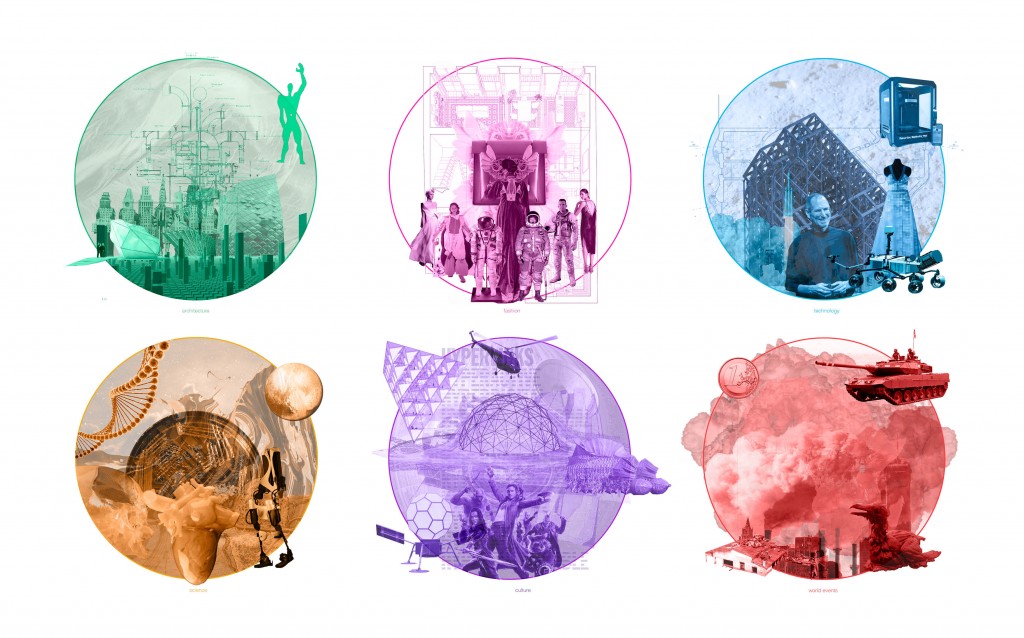WANDERERS
“Wanderers explores the possibility of voyaging to the worlds beyond by visiting the worlds within. 3D printed wearable capillaries designed for interplanetary pilgrims are infused with synthetically engineered microorganisms to make the hostile habitable and the deadly alive.”
Mediated Matter, Wanderers, 2014
Each of the four projects were printed using a range of plastics with different densities to house different biological processes. Through the use of synthetic biology, matter creates micro habitats or systems within different pockets or tracks, transforming to suit the needs in a specific habitat.
Mushtari, designed for Jupiter, is a 3D printed translucent strand resembling intestines that sits around the lower abdomen. It consumes and digests biomass, absorbing the nutrients and generating energy to sucrose as well as expelling waste.
 Al Qamar is a wearable biodome to be fitted around the neck and over the shoulders. The external pods are filled with algae for air purification and biofuel collection to store and produce oxygen.
Al Qamar is a wearable biodome to be fitted around the neck and over the shoulders. The external pods are filled with algae for air purification and biofuel collection to store and produce oxygen.
 Zuhal, is designed to survive the vortex storms of Saturn. Bacteria on the bodices swirling texture converts Saturn’s hydrocarbons into edible matter.
Zuhal, is designed to survive the vortex storms of Saturn. Bacteria on the bodices swirling texture converts Saturn’s hydrocarbons into edible matter.
 Otaared designed for Mercury is a protective exoskeleton that sits around the head.
Otaared designed for Mercury is a protective exoskeleton that sits around the head.
 The Team included Neri Oxman and her Mediated Matter Group from MIT created the projects with the help of Stratasys, a company specializing in 3D printing. Christopher Badeir and Dominik Kolb, two German designers, helped in creating the computational growth patterns.
The Team included Neri Oxman and her Mediated Matter Group from MIT created the projects with the help of Stratasys, a company specializing in 3D printing. Christopher Badeir and Dominik Kolb, two German designers, helped in creating the computational growth patterns.
STATEMENT
The expansion of the body and contraction of the habitat produces architecture
Through many discussions, the idea of clothing as a shelter came up. What would happen if clothing was our only shelter? We felt that the idea of habitat was changing and primarily contracting, while our bodies were expanding with the addition of clothing and prosthetics to name a few. Contraction looks at the human body scale, while expansion explores the areas beyond earth.

PARAMETERS
Six main topics are explored which we believe are crucial in understanding what was happening at the time of the Wanderers Project. These are Fashion, Architecture, Science, Technology, Culture and World Events. Within each general topic, parameters are explored including movements, literature, inventions, movies, exhibitions to name a few.
 _______________________________________________________________________________________
_______________________________________________________________________________________
TIME-FIELD
In creating the cartography, we were inspired by constellations as Wanderers is about outer space. We began with the axis, the x being the groups and the y being expansion and contraction.

Next, the points that in our opinion represent Wanderers the most are plotted.

Following the main points came all the parameters which were connected to the latter. The varying points represent the time span in which they occurred.

The varying line types represented the different relationships, direct, indirect, secondary constellations and main constellations. Main constellations developed as a result of the connections between parameters the points plotted to represent Wanderers.

Finally, the grid on which the points were plotted was designed to express expansion and contraction. At the denser areas of information the grid is designed to be smaller and where there are less points the grid expands.

This method produces the final cartography below.
Wanderers is a project of Iaac, Institute for Advanced Architecture of Catalonia developed at Masters in Advanced Architecture in 2018 by:
Students: Ankita Alessandra Bob, Holly Victoria Carton, Fiona Clara Louise Demeur, Kristine Kuprijanova, Aishath Nadh Ha Naseer, Jose Isidro Pastor Tormo
Faculty: Manuel Gausa, Jordi Vivaldi Piera
Assistant: Mohamad Elatab